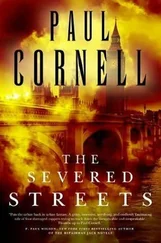“Did Frazier know she had that money?”
“Yeah he did.”
“Did he know where it was?”
“Yeah.”
Garvey nods, giving this fact a moment of thought. Then a Western uniform bounds up the stairwell and into the hall of the apartment, looking for the detective.
“What’s up?” asks Garvey.
“The rest of the family wants to come up.”
Garvey looks at the lab tech. “You have everything you need?”
“Yeah, I’m just packing my stuff.”
“Yeah, go ’head,” says Garvey to the uniform, who goes downstairs to open the front door of the building. Seconds later, half a dozen relatives, including the victim’s mother and older daughter, move quickly into the apartment, creating instant pandemonium.
The older family members busy themselves with taking stock of the kitchen appliances, the color television, the stereo system. For places like Gilmor Street, the reclamation of a victim’s valuables is a postmortem imperative, less from greed than from the certain knowledge that as soon as word of the murder hits the street, any number of break-in artists will plan to acquire the worldly wealth of the newly departed, providing they can get into the place after the police leave and before the family has a chance to think. Grief may come later, but tonight the victim’s mother has no intention of leaving to the wolves that multichannel home entertainment center.
The rest of the family is curious in a morbid way. A cousin points to the coagulated red pool on the bedroom carpet. “That Lena’s blood?”
A Western uniform nods, and the cousin turns to the victim’s older daughter.
“Lena’s blood,” he says again. Bad thought. Because now Jackie’s older sister is wailing for all she’s worth, making a bee-line for the red stain, her arms extended, palms open wide.
“MOMMY, MOMMY, I SEE MOMMY.” The kid is rubbing her hands through the pool, gathering up as much of the wetness as she can. “MOMMY. I SEE MOMMY…”
Garvey watches as the cousin and another relative grab the older daughter and lift her away from the blood.
“… MOMMY, DON’T GO, MOMMY…”
The girl comes up screaming with her forearms extended, both palms covered with blood. Sensing an ugly dry cleaning bill, Garvey steps back, then moves toward the door.
“All right, Jackie,” he says. “Thank you, honey. You’ve got my phone number, right?”
Jackie Lucas nods, then turns away to comfort her sister. As the screaming reaches a still higher pitch, Garvey makes his escape, following the lab tech down the steps and crawling into the cold interior of the Cavalier. He has spent a little less than four hours working the scene.
Before returning to the homicide office, Garvey makes a point of driving another twelve blocks north to see if an extra hand is needed on a suspicious death call that came in three hours after the call for Gilmor. Earlier, Garvey telephoned the office and heard from Dave Brown that the second call might also be a murder and might in some way be related to Gilmor Street. Garvey arrives on the second floor of a Lafayette Avenue rowhouse to find Rick James and Dave Brown working the murder of a fifty-year-old man.
Like Lena Lucas, the Lafayette Avenue victim has been shot in the head and stabbed repeatedly, this time in the chest. And like Lena Lucas, there is a pillow near the victim’s head, marred by a large amount of gunshot residue. Moreover, the face of this victim is also covered by the same series of shallow cuts-more than twenty this time. Obviously dead for some time, the victim was found by several family members who had become concerned and entered through an unlocked rear door. Here, too, there was no sign of forced entry, but this time the room where the victim was found had been ransacked.
The two cases become unequivocally joined when Garvey learns that the dead man is Purnell Hampton Booker, the father of one Vincent Booker, who is the same entrepreneurial lad who works for Robert Frazier, who sells dope and sleeps with Lena Lucas. Standing in the dead man’s bedroom, Garvey knows that the same hand almost certainly took both lives.
Leaving Brown and James to work their scene, Garvey returns to the homicide office and buries himself in paperwork at a back desk. He’s still there when the detectives return from Lafayette Avenue.
As if the immediate similarities between both crime scenes aren’t enough to link the killings, the spent bullet pulled from Purnell Booker’s brain at the next morning’s autopsy is a.38 ass-backward wadcutter. Later that evening, Dave Brown, the primary on Lafayette Avenue, saunters over to Garvey’s desk with an ident photo of young Vincent Booker.
“Yo bunk, looks like we be working together.”
“Looks like.”
As it happens, already that afternoon Garvey has heard from an anonymous tipster, a woman who called the homicide office to say she heard talk at a West Pratt Street bar. One man was telling another that the same gun was used to kill Lena Lucas and the old man on Lafayette.
Interesting rumor. A day later, ballistics says the same thing.
MONDAY, FEBRUARY 29
A week has passed since Lena Lucas and Purnell Booker were found dead on the same night, yet the two cases are still moving slowly, inexorably, forward. Fresh reports clutter both files, and in the Baltimore homicide unit, where one day’s violence is overwhelmed by that of the next, a thick file is regarded as a healthy sign. Time itself mocks the most careful investigations, and a detective-conscious of that fact-spends his precious hours working the best angles, bringing the likely witnesses and suspects downtown, hoping that something will fall. For he knows that well before he has a chance to play long shots or, better still, to embark on a prolonged, detailed investigation, another case folder will arrive on his desk. But somehow, in some special way, the law of diminishing returns has never applied to Rich Garvey.
“He’s like a dog with a bone,” Roger Nolan once told another sergeant with pride. “If he gets a case and there’s anything there at all, he won’t let go of it.”
Of course, Nolan only says that to other sergeants; to Garvey he says nothing of the sort, cleaving instead to the fiction that it’s normal for a detective to drop a case only when there’s nothing left to give up on. It is, in truth, anything but normal. Because after fifty or sixty or seventy homicides, the reality is that the dead-yo-in-the-alley scenario begins to wear thin. And nothing deflates a detective more than going back to the office, punching a victim’s name into the admin office terminal and pulling out five or six computer pages of misbehavior, a criminal history that reaches from eye level to the office floor. Burnout is more than an occupational hazard in the homicide unit, it is a psychological certainty. A contagion that spreads from one detective to his partner to a whole squad, the who-really-gives-a-shit attitude threatens not those investigations involving genuine victims-such cases are, more often than not, the cure for burnout-but rather those murders in which the dead man is indistinguishable from his killer. An American detective’s philosophical cul-de-sac: If a drug dealer falls in West Baltimore and no one is there to hear him, does he make a sound?
After four years in homicide and thirteen on the force, Garvey is one of the few residents of the unit still unafflicted with the virus. It is telling that while most detectives can’t keep the cases straight in their minds after a few years in the trenches, Garvey can immediately tell you that out of twenty-five or twenty-six cases in which he was the primary, the number of open files can be counted on one hand.
“How many exactly?”
“Four, I think. No, five.”
Читать дальше












